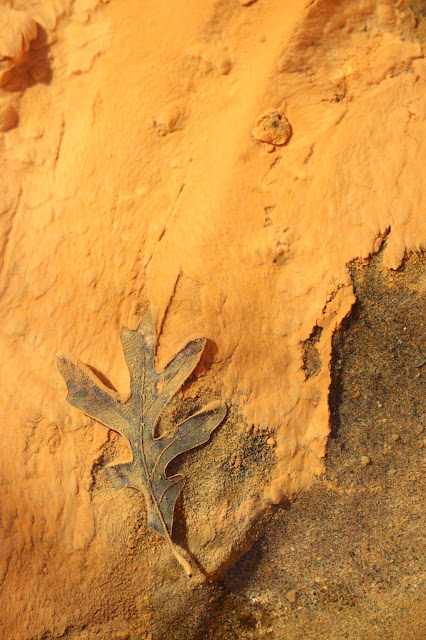A small subset of my ever-growing collection is petrified wood. The pieces come from all over the world, but mostly the USA. They are tan, black, white, pink, gray, blue and even rainbow hued, depending on how they preserved.
The most colorful ones on my collection are casts in various types of quartz, like the pink chalcedony limb cast from Oregon, or preserved by permineralization, like the pale blue and gray wood from Wyoming's Blue Forest, and the Arizona rainbow wood.The pink chalcedony cast was formed when the limb was buried, then rot away, leaving a hole. The hole then filled in with the chalcedony. The other two absorbed the minerals before rotting away, until the wood was eventually replaced by the absorbed minerals. The permineralized wood retained the best cell structure and can the original sometimes be identified from small samples by examining the cell structure under a microscope.
 |
| Pink chalcedony limb cast from the Cretaceous of Oregon. The hole in the center is filled with minuscule quartz crystals. |
Iron oxides can create red, orange and yellow coloring, as with the casts I found in South Dakota. There I found not just the limb casts, but leaf impressions as well. These are from an iron-rich deposit in the Cretaceous Hell Creek formation in South Dakota.
 |
| Leaf impression of an Aurucaria longifolia (conifer) leaf | , Cretaceous, South Dakota |
 |
| small limb cast with iron oxide minerals, Cretaceous, South Dakota |
The black petrified wood usually comes from carbon-based minerals. Some of mine is carbonized wood, similar to charcoal. Over millions of years of heat and pressure, the carbon in the wood turned to lignite, resulting in very crumbly, black material. If the lignite I have was further compressed and heated, it would have became jet, a kind of soft gemstone. In other places, the wood rot away and was filled with fine, carbon-based sediments in the same manner as the chalcedony casts. What is more, while I do not have any myself, there are also black pieces colored by iron pyrite or manganese.
 |
Lignite petrified wood from the Cretaceous deposit at Dinosaur Park in Laurel, MD
|
Then there's my local stuff. Like most petrified wood, Delaware's material is replaced by silicon minerals (called silicification). We have almost completely white wood, which is replaced by pure silica. There is also some that occurs as brown/tan, having been replaced by silicon dioxide. Our local permineralized, colored wood retained not only the shape and cell structure, but the grain patterns in the wood. It can appear almost indistinguishable to modern wood that was recently cut, until you try to pick it up and feel the weight!
 |
| Silicified cypress wood, Odessa, DE, age unknown. Top one is about 3 inches long. The bottom one is about 2 ft long! |








I found your blog when I was perusing The Fossil Forum. I have a hearty affection for petrified wood and have pieces from all over the US. Here in Arkansas around Mt Ida the petrified wood is beautiful and I cannot leave the smaller pieces behind. Fortunately for me there are elementary and high school teachers always eager to take a few off my hands. The same is true of crystals and quarts. A few weeks ago, I brought home a small tree trunk that my husband keeps asking when I’m going to finish grooming it. He is not a fossil fan, but he goes with me and helps me get the treasures home. I do enjoy your writing and that is coming from a retired writing professor.
ReplyDelete